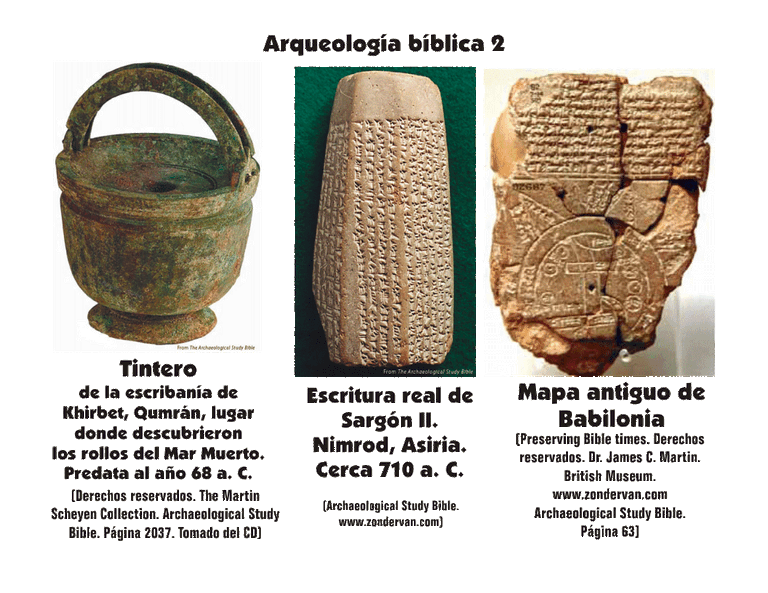The archaeological investigations in the area where the events narrated in the Bible take place have as an added result the verification of the facts, places and characters that appear cited in the different books that make up the Bible. [Citation needed] It has even been reached create the term of biblical archeology to denominate a part of the archeology that is in charge of studying the places indicated in the Bible. [citation needed]
There are several cases in which archaeological discoveries have indicated congruence with biblical facts or characters. Among those discoveries are the following:
King Sargon II of Assyria. This character, which appears in Isaiah 20: 1, could not be confirmed until in 1843 the ruins of his palace were discovered. There were writings in which the conquests of the cities of Samaria and Ashdod that also appear in the book of Isaiah are reported. [Citation needed]
Joaquin, king of Judah The discovery of the tablets of Babylon allowed the confirmation of the existence of King Joaquín de Judah and his five children who appeared named in the Second Book of Kings and the First Book of Chronicles. [Citation needed]
The seal of Yehujal. In 2005 the archaeologist Eilat Mazar discovered a clay seal in which was named Yehujal (Jehucal or Jucal), a Jewish official named in the book of Jeremiah. [Citation needed]
Findings in Nineveh. In the palace of Sennacherib there is a bas-relief showing the Assyrian troops taking captives to the Israelites after the fall of Lachish, a fact recounted in the Second Book of Kings.30 The pieces known as the Annals of Sennacherib relate the events that took place. during the reign of Hezekiah and this same character. It is also curious how in the list of cities conquered by the Assyrians Jerusalem does not appear, which agrees with the biblical account that they were defeated at their doors, 31 just as the murder of Sennacherib is reported, which are included in the Second Book of the Kings, chapter 19, verse 37 (Also in 2 Chronicles 32:21 and in Isaiah 37: 37-38) .32 33 "And it came to pass, as he bowed down in the house of Nisroch, his god, Adramélec and Sarézer , their children, they overthrew themselves by the sword, and they themselves escaped to the land of Ararat. And Esarhaddon his son began to reign instead of him. " (2 Kings 19:37) .34 Also mentioned in Isaiah 37: 37-38.35 Verse 38 is identical to 2 Kings 19: 37.36 Sennacherib did not die immediately after arriving in Nineveh; Apparently, this could happen about twenty years later. It depends on Assyrian and Babylonian records of dubious reliability. There is an inscription of his son Esar-hadon confirming his murder and escape to the land of Ararat. -Ancient Records of Assyria and Babylonia, by D. Luckenbill, 1927, volume 2, pages 200, 201.
The Cylinder of Ciro. It was found in Sippar, near Baghdad (Iraq). It narrates the conquest of Babylon by Cyrus the Great. Some see in the story of Isaiah 13: 1,37 13: 17-19,38 and 44: 26-45: 339 the prophecy of the destruction of Babylon by Cyrus. Also in the cylinder is the policy of Ciro to let the deported peoples return to their homeland, as happened with the Israelites. The long and difficult journey of return of the Israelites to Judah and Jerusalem could last about four months, according to Ezra 7: 9.40. They would have arrived on the seventh month (Tisri) of 537 a.C. (Ezra 3: 1-6) .41 </ ref>
Archeology has also provided interesting discoveries regarding the conformation of the biblical texts themselves. [Citation needed] The discoveries of the Gospel of Thomas and the Gospel of Philip, for example, reinforced the Q Hypothesis. [Citation needed] A few scholars they are inclined to think that the Gospel of Thomas is older than the canonical 4 and that like Matthew and Luke, he had Q as a documentary source. [citation needed] According to those who support the hypothesis of Source Q, the Gospels more old ones would be collections of sayings of Jesus that would not narrate the crucifixion or the resurrection, but would worry about keeping the record of the Master's teachings. [citation needed]
